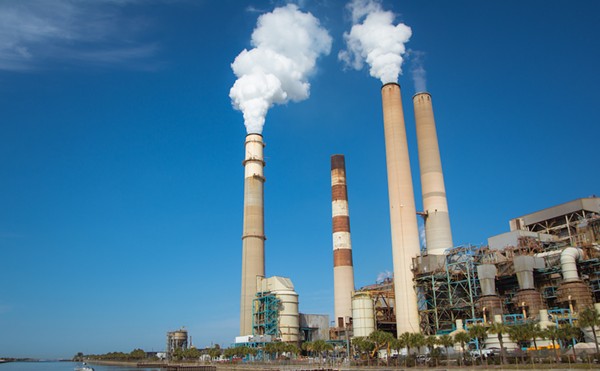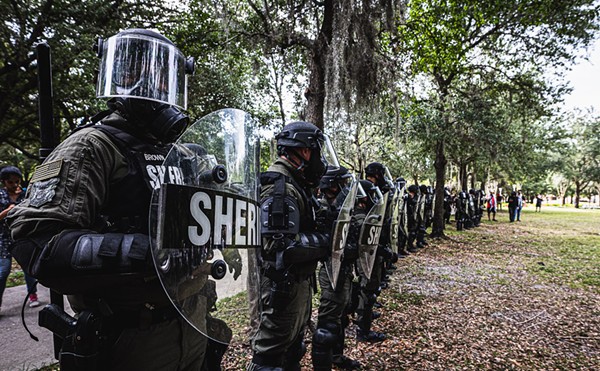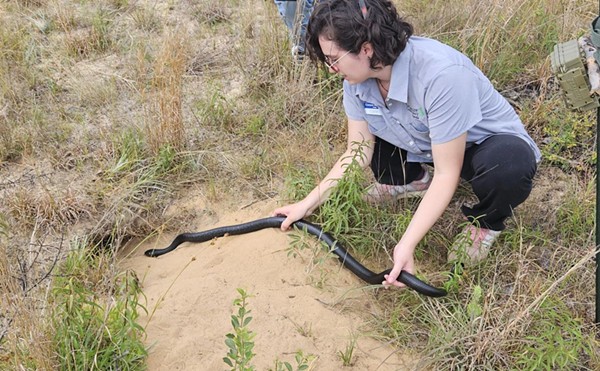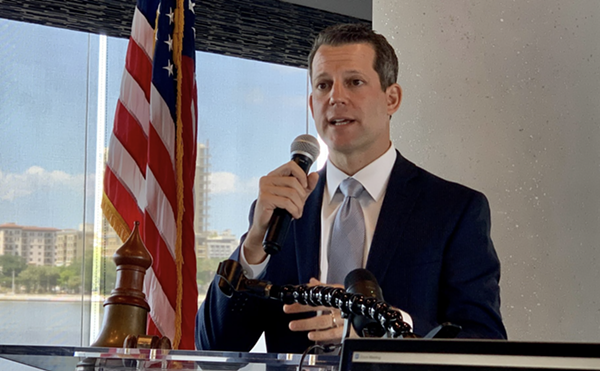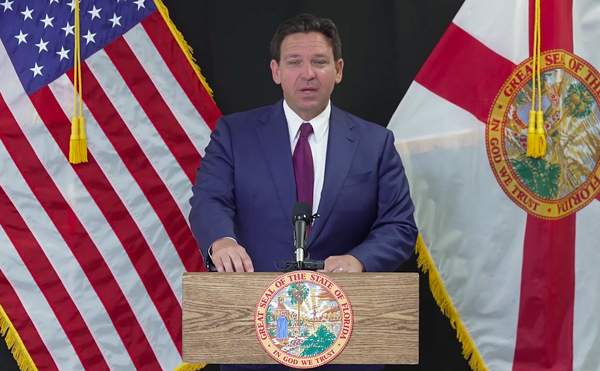It’s a story Florida’s environmental champions have heard many times before: decision makers ignoring the pleas of the public (and the science) and siding with monied interests. This time, it’s happening in south Tampa Bay.
Despite objections from residents, a new 3,837-acre phosphate mine could be coming to eastern Manatee County.
On September 15, the Manatee Board of County Commissioners will vote on whether to rezone an area known as the Wingate East Parcel from agriculture to mining/extraction as well as on a master mining plan for Wingate East Mine. These changes, requested by Mosaic Fertilizer, LLC, were recommended by the Manatee County Planning Commission during an all-day meeting on August 18, despite objections from several members of the public.
One of them, the Florida director of the Center for Biological Diversity, warned that the zoning changes Mosaic is requesting will contribute to Florida “shifting this environmental baseline from very rural and agricultural to mining.” Jacyln Lopez told planning commissioners that mines like this are detrimental to threatened species like the bird known as the crested caracara, as well as to the “wood stork, eastern indigo snake and of course Florida scrub jay.”
“The leading cause of species extinction is habitat loss,” she said. “The phosphate mines will remove the land, the habitat, permanently. The species will be displaced, very likely permanently.”
Phosphate mining has long been a major industry in west central Florida, where phosphogypsum stacks — a byproduct of processing phosphate into fertilizer — rise out of the otherwise flat landscape near places like Bartow and Mulberry. Florida produces three-quarters of the U.S.’s phosphate and it’s an $85 billion industry, notes environmental writer Craig Pittman in the Tampa Bay Times. Mosaic is the world’s largest producer of phosphate, a mineral widely used to fertilize crops. The company is influential in local and state politics, even if the U.S. Environmental Protection Agency hit them with a $2 billion settlement over failing to properly store over 60 billion gallons of hazardous waste, which the EPA last year called “the largest amount ever covered by a federal or state... settlement.”
To environmentalists, pretty much every aspect of the mining process is detrimental to the landscape — even efforts to recover the land that was torn up in pursuit of the mineral.
Lopez said she has seen former mining land that had been restored by Mosaic in a controversial process known as reclamation. Those reclaimed lands support eucalyptus and cows, which Lopez points out are not native, endemic species.
“The habitat is not going to be restored to its previous function,” Lopez said.
Mosaic owns or controls 380,000 acres of land in west central Florida and about 70,000 acres of that are being actively mined. The proposed Wingate East Mine is in eastern Manatee, along the border with Hardee County and adjacent to other Mosaic phosphate mines (Wingate Creek, Wingate Extension and Four Corners). Across the border in Hardee is another proposed phosphate mine, called the Ona mine, which the vice chair of the Manatee-Sarasota Sierra Club, Andy Mele, is promising to fight in court.
Bart Arrington, Mosaic’s mine permitting manager, described the proposed mining at Wingate East to the planning commissioners during that meeting last month. He said they’ll use two methods to mine. To the west of Duette Road, Mosaic plans to continue to use dredge mining — with two dredges. On the east side they’ll use drag lines.
“There are two layers that we have to deal with when we mine,” Arrington told the Planning Commission at the August 18 meeting. “The top is the ‘overburden’ layer; that consists of sand and clay. For the dredge-mining project we use one dredge to pump that away. For a drag line, the drag line pushes that layer to the side, okay, and then exposes the second layer we’re interested in, which is the ‘matrix.’”
But environmental activist Mele says “overburden” is an Orwellian term for what the rest of us call “natural Florida habitat.” He claims nature is destroyed by phosphate mining. Sure, some of the large mobile animals will walk or fly away, or be relocated, but the plants will be destroyed and habitat — like gopher tortoise burrows, which are home to dozens of other creatures — will be wiped out.
What’s below the overburden? That’s called the matrix. That’s where the phosphate is, so the matrix gets further processed. It contains sand, clay and phosphate rock. Another dredge mines that matrix by digging it up with a drag line.
“We take that layer and we slurry it up and we send it to the plant,” Mosaic’s Arrington says, where it’s separated into the three parts. “Sand goes back into the mine cuts for reclamation, the [phosphate] rock leaves the site to be processed into water-soluble fertilizer, and the clay — that’s out there now — goes into the clay settling areas.”
Clay settling areas are huge reservoirs of water and fine clay built on top of a spent mine — they’ve also been called slime ponds. They’re surrounded by earthen dam walls built up above the surrounding landscape like a landfill. Eventually all the water is decanted or evaporates, and what’s left is a giant hill of clay.
There’s naturally occurring radioactivity in the soil and rocks that are mined, and some members of the public expressed concern that concentrating the clay in settling areas would mean radioactivity levels higher than normal. But Mosaic said it’s not a concern.
The phosphate rock is shipped to fertilizer plants for processing, the byproducts of which are stored in phosphogypsum stacks. Bob Navin of Friends of Horse Creek calls the stacks “hazardous waste.”
No stacks are proposed for the Wingate East Mine, but the phosphate has to get processed, and the waste has to be stored somewhere.
A 200-foot setback from roads is required for mine activities, but Mosaic is requesting a setback waiver so that mining can encroach to within 140 feet from Duette Road. County staff did a stability analysis and gave that waiver a green light.
After an area is mined, Mosaic is required to restore it to — well, not its natural state, but something more natural than an open mine. The company is proposing to mine the area until 2037 and will have until 2041 to complete the reclamation plan.
But some environmentalists are concerned that what will grow on that reclaimed land is far inferior to the ecosystems that will be destroyed to mine it.
Mele says there are some reclaimed areas where the only plant that will grow is a weed native to the Eastern Hemisphere called “cogon grass.” During a speech in St. Petersburg in August, he spoke about cows dying after grazing on reclaimed lands and the use of helicopters to spray the herbicide Round-Up to control the cogon grass.
The Manatee County staff report to the Planning Commission points out that “686 acres of jurisdictional waters, including 649 acres of wetland habitats,” will be impacted.
Debbie Mafera and her husband live near Myakka City, right across the street from wetlands that would be impacted by the mine.
“It destroys streams and river water quality. ...It draws down the aquifer. Its runoff overburdens. It’s repressive to county economic growth. It destroys old-growth trees. ...It contributes to sinkholes. It uses huge amounts of fuel,” Mafera told the commissioners.
The only commissioner to vote against recommending the changes Mosaic is asking for was Matt Bower. He said he still has reservations about how the mine would impact the environment. Bower is concerned about the adverse impact on water quality within the Lake Manatee and Peace River watersheds, and protection of native wildlife and threatened species.
“They haven’t met the burden of overriding public benefit,” Bower said.
Mosaic’s Arrington concluded that the phosphate company should be granted the zoning changes despite impacts on wetlands because the county’s comprehensive plan only forbids it unless “there’s no practical alternative” and “no overriding public benefit.” Arrington argued that there’s no alternative because phosphate mining can only occur where there’s phosphate. He says Mosaic provides public benefit through reclamation and by preserving some of the wetlands.
Another public benefit is a $2.5 million payment Mosaic is proposing to a nonprofit called the Manatee Community Foundation. But several residents questioned that gift and one planning commissioner, Paul Rutledge, said he didn’t even know what that group is.
Despite the testimony from residents — only one spoke in favor of mining — the Planning Commission recommended the zoning changes sought by Mosaic by a 5-1 vote. Assistant County Attorney Bill Clague told commissioners that unless there were specific legal reasons in the mining ordinance to deny the zoning changes sought by Mosaic, the county could get sued. So Clague cautioned commissioners that the reasons for their decision — what he calls their “filtering” — should be consistent with the comprehensive plan and its mining ordinance.
The Sierra Club’s Mele said that such directives show the phosphate industry’s influence.
“The whole phosphate process is being driven by the county attorneys’ fearmongering about Harris Act lawsuits. Mosaic has beaten three counties, and in doing so has them all cowering,” Mele said in an email.
The Manatee Board of County Commissioners will vote on Mosaic’s request at a meeting on September 29.




